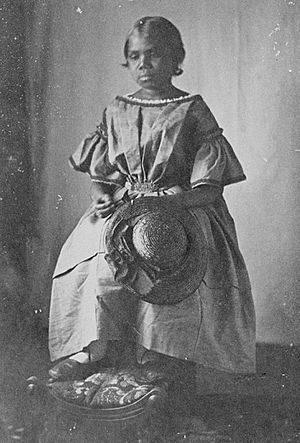Bessie Flower facts for kids
Quick facts for kids
Bessie Flower
|
|
|---|---|

Portrait of Bessie Flower as a child while at Annesfield.
|
|
| Born |
Elizabeth Flower
c. 1851 |
| Died | 14 January 1895 |
| Occupation | Teacher |
| Spouse(s) | Donald Cameron |
Bessie Flower or Bessie Cameron (born around 1851, died 1895) was an important Mineng Noongar woman. She came from Albany, Western Australia. Bessie went to school at Annesfield. She became very close to the headmistress, Anne Camfield.
Throughout her life, Bessie fought for Aboriginal rights. She worked hard to help families stay together. In 1867, Bessie moved to the Ramahyuck Mission. This mission was in Gippsland, Victoria. There, she worked as a teacher.
Bessie Flower's Early Life
Bessie Flower was born to John and Mary Flower around 1851. Her family were Noongar Aboriginal Australians. Her parents worked for Henry and Anne Camfield. Henry was a government official. Anne Camfield started a school for Aboriginal children. Bessie and her siblings went to this school. Bessie became a Christian and was a very good student.
People said Bessie was a "smart and bright child." She could speak French. She also played the harmonium and chess. Bessie was excellent at playing the piano and singing too. In 1864, she went to a special 'model school' to continue her studies.
When she returned to Annesfield in 1866, she helped Anne Camfield. Bessie worked as a teacher's assistant. She also played the organ at the local Anglican Church. In 1871, a government report mentioned her. It said she taught and played music in Sydney.
Life and Work in Gippsland
In 1867, Bessie was offered a new chance to teach. She was asked to be a teacher at Ramahyuck Mission in Gippsland, Victoria. She married Adolph Donald Cameron when she was 17. Adolph was also of Aboriginal heritage. They had eight children together.
Later, a new law was passed in 1886. This law was called the Half-Caste Act. It forced Aboriginal people under 34 years old to leave missions. This law affected Bessie and Adolph. They were forced to move away from their family. They had to live in a community that was not always welcoming.
Bessie found that the authorities were trying to separate her from her children. The person in charge of this decision was Friedrich Hagenauer. Luckily, Bessie and Adolph were allowed to return to Ramahyuck Mission. However, two of their daughters were made to work as domestic servants.
For the rest of her life, Bessie lived at Ramahyuck at times. She continued to help her children and other Aboriginal women. She worked hard to keep families together. Bessie died in 1895 from a stomach infection. She was buried in the Bairnsdale cemetery. Her husband, three daughters, and two sons survived her.

